This article represents the opinions of its author. The views expressed here are not necessarily representative of The Sunrise News staff as a whole.
What do Little River Canyon and Moss Rock Preserve have in common? Sure, they’re all sites for different parks and preserves, they have some great hikes, they even have rare biodiversity that can only be found in their respective areas. But, all of these places also have some of the best climbing in the state.
Moss Rock Preserve, specifically, has highly accessible bouldering. Bouldering is a type of climbing that doesn’t use ropes, and instead of climbing massive rock faces hundreds of feet in the air, the highest you climb is about 20 to 25 feet up. The lack of ropes means that rather than relying on a belayer, which is the person making sure you don’t fall, and the rope, you rely on your spotter and some pads. Your spotter is making sure that you don’t fall weirdly while they protect your head. The pads, well, are pads to cushion your fall.
An appealing part of bouldering, as compared to sport or traditional climbing, is the low-level entry in terms of cost. While you can spend thousands on rope and different gear for sport and traditional, you only really need shoes, some chalk and crash pads to boulder. While that can still be a few hundred, it’s comparatively pretty cheap.
However, if you don’t want to spend that kind of money but still want to try it out, you really have two options. Your first option is to find a friend and hope they have spare gear to let you try it out. The second option is to go to a climbing gym. There’s only two climbing gyms in the Birmingham area, with those being High Point Climbing and Fitness and Birmingham Boulders. Both are great places to try climbing with some equally great and friendly people to help you out.

If you’re interested, you can find more information and rates for High Point here, and Birmingham Boulders here.
Now, back to Moss Rock Preserve; on top of some of the best bouldering in the state, it also happens to be in Hoover, Ala., about 40 minutes from where I live. At 349 acres of sprawling forest, including longleaf pine forest areas, a prairie restoration site, waterfalls, boulder fields and sandstone outcroppings, Moss Rock Preserve has a little bit of everything Central Alabama can geographically offer.
The preserve’s main sandstone glade and several boulder fields are part of the same geologic formation that formed the rock features in Little River Canyon Preserve, Horse Pens 40 another popular climbing destination in Alabama, and other sites around the Cumberland Plateau. Sandstone glades are extremely rare in the southeast and according to the City of Hoover, the sandstone glade at Moss Rock Preserve is a variant that is one of 35 in the world. Glades in general are extreme environments that harbor several sensitive rare species of plant life due to the lack of other more competitive species of plants that require more soil and better conditions.
Moss Rock Preserve also features some rare biodiversity which includes the Longleaf Pine tree and several rare wildflowers like Nutall’s Rayless Goldenrod, Menge’s Fame Flower, Harper’s Dodder and Elf Orpine.
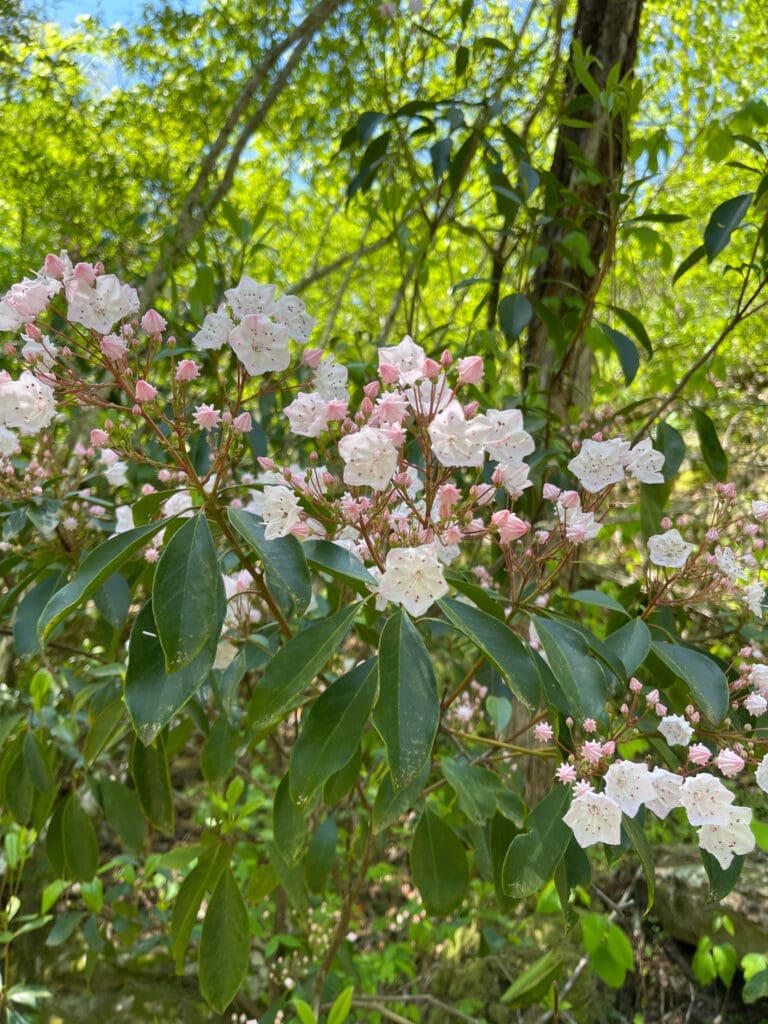
Getting to the sandstone glade is pretty straightforward. We parked at the parking lot closest to the boulder field and the main trailhead off of Preserve Parkway. By going down the initial trail – passing the lost and found and porta potties – you’ll find yourself at the start of a maze of trails that meander through the boulder field. If you make your way downhill along the trails, sticking to the right, you should find a trail marker labeled 6. From the marker, go left along the white trail until you get to a bridge. Cross the bridge on to the blue trail and follow it until you find yourself in the Sandstone Glade. There’s several waterfalls to the left of the glade and islands of plant life dotted throughout the rock outcropping. Be sure to be as careful as possible if you’re walking through the glade as the plant life is extremely delicate. An excellent map can be found at this link. The boulder field is toward the bottom-middle of the preserve.
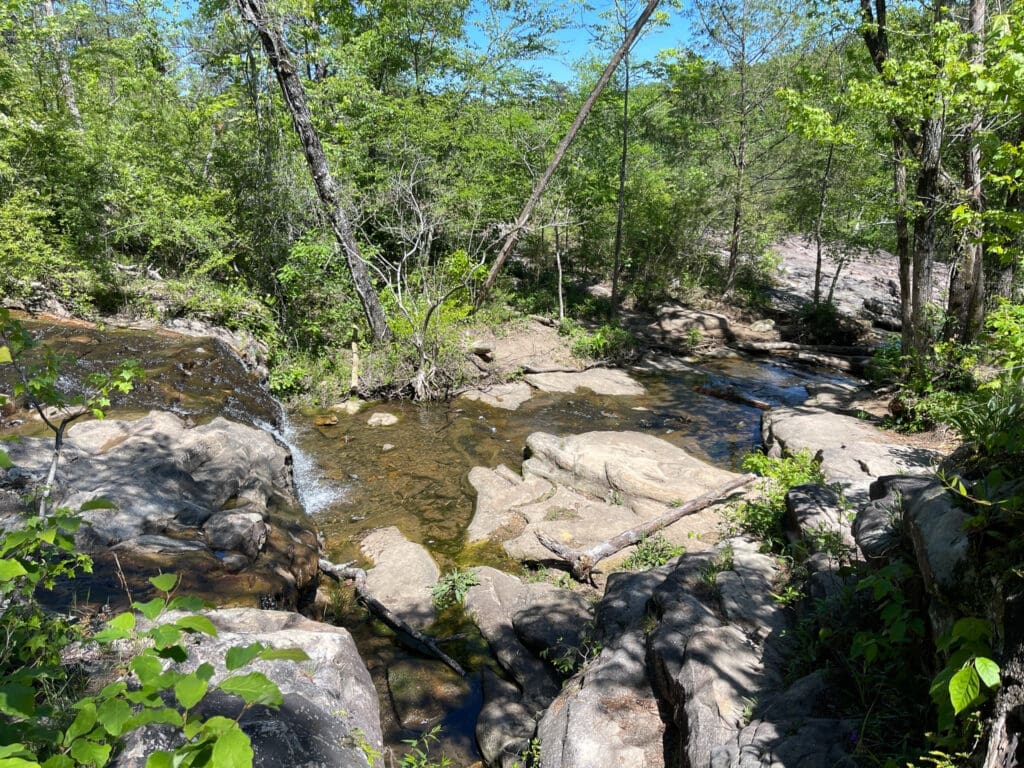
There is also a variety of wildlife that can be found in the preserve if you keep a keen eye out. Within 15 minutes of being on the blue trail, my roommate, Robbie and I, found a midland water snake and two salamanders by one of the waterfalls. While we didn’t find any of the rare plant life in the sandstone glade, we found a number of different grasses and cacti that we haven’t seen elsewhere.
Being smack dab in the middle of Alabama makes Moss Rock Preserve one of the more accessible areas to get to for all things bouldering. It also helps that Birmingham Boulders is a short drive around the corner and offers crash pad rentals for $25 a pad.
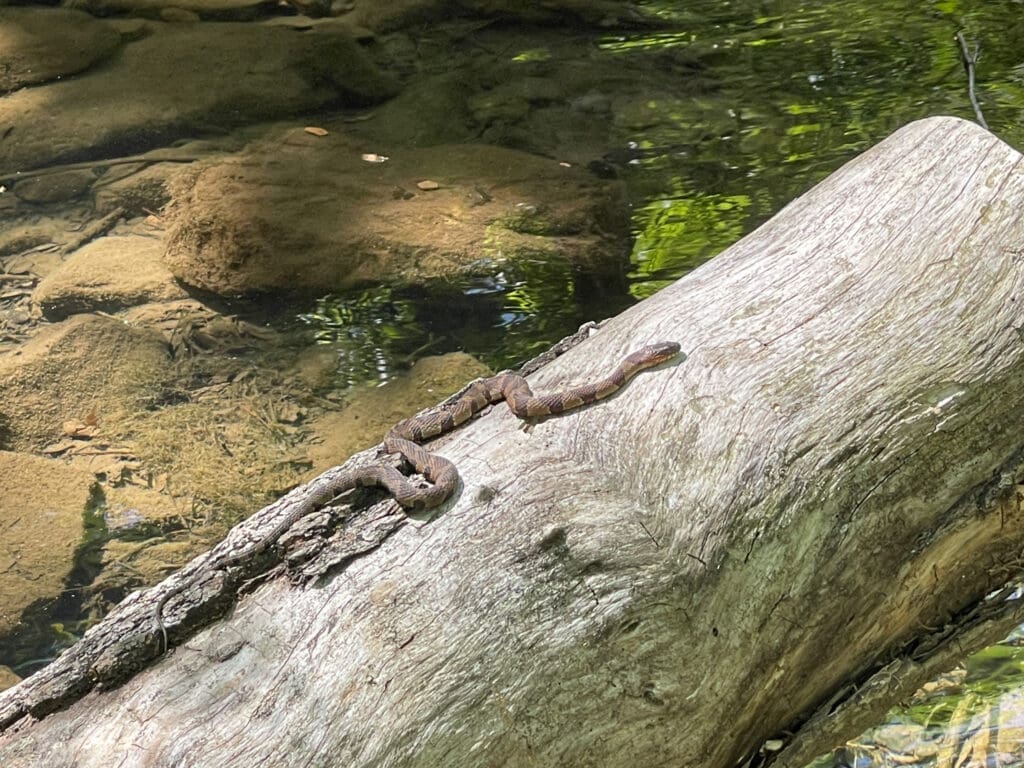
On your way to waterfalls and the sandstone glade from the Preserve Parkway trailhead you’re met with a massive boulder field. The boulder field is unlabeled, but online it’s primarily split into three different sections: the Grass Man area, the Ozzy area and the Lost Roof area. Most boulders also have their own names, but that’s not always the case.
Whenever you boulder or climb, you always want to have some kind of guidebook. We mainly used a 2009 guidebook for Horse Pens 40 and other climbing areas in Alabama, including Moss Rock Preserve, and printed out what we wanted. We actually got the digital copy of the guidebook from another climber we met at High Point. If you’d like to purchase the full version you can here, or the City of Hoover also provides a free guidebook here.
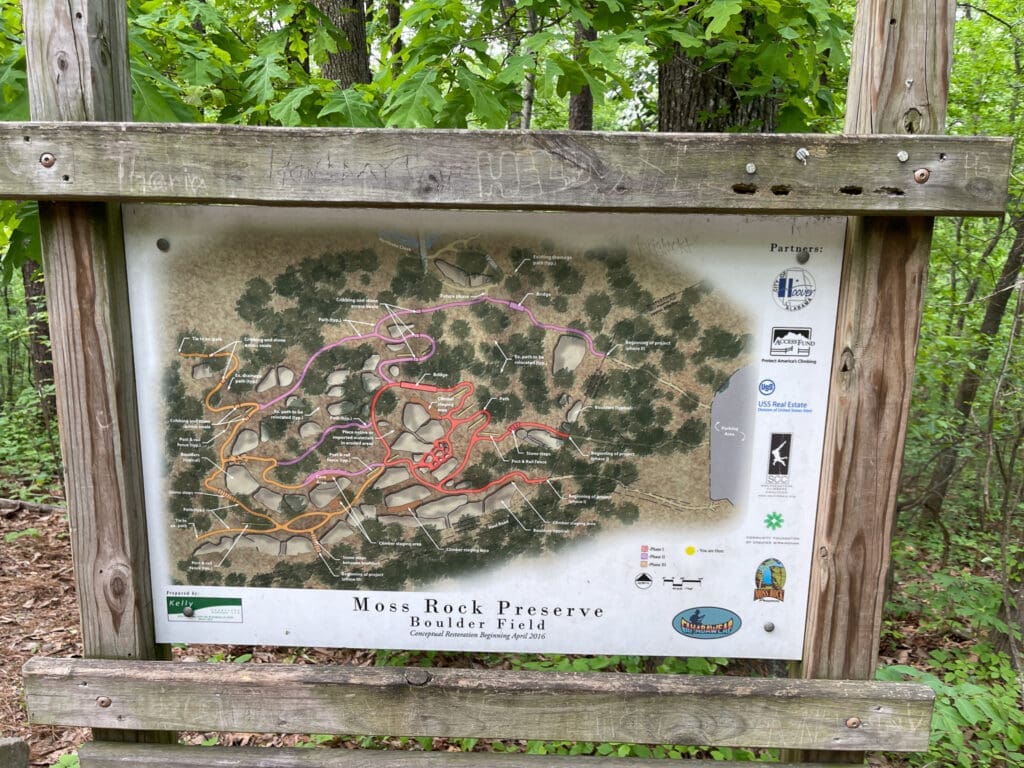
The guidebook gave us information on the area and had a few stories about some of the people who helped establish routes, like John Gill, who is considered to be the father of bouldering. From Tuscaloosa, Gill helped usher in the modern climbing era by introducing the use of gymnast chalk, and the short dynamic moves known in bouldering today.
But, the main resource a guidebook provides is routes. Moss Rock Preserve has more than 100 bouldering routes to choose from, of all varying difficulties. A guidebook shows you where those routes are and includes photos, their grade of difficulty and a short description of how to do them.
If you don’t have access to a guidebook, you can also use something like Mountain Project. Mountain Project is a community-sourced website that’s dedicated to uploading route information, photos and is community-graded. It’s basically a guidebook written and updated by hundreds if not potentially thousands of different climbers.
After getting our guidebook ready, our crash pads from Birmingham Boulders and grabbing our daypacks, Robbie and I headed out to boulder at Moss Rock for the first time. We weren’t sure what we were doing, but from talking to other climbers and hearing from the general community, we decided to just put out the pads and send some climbs.
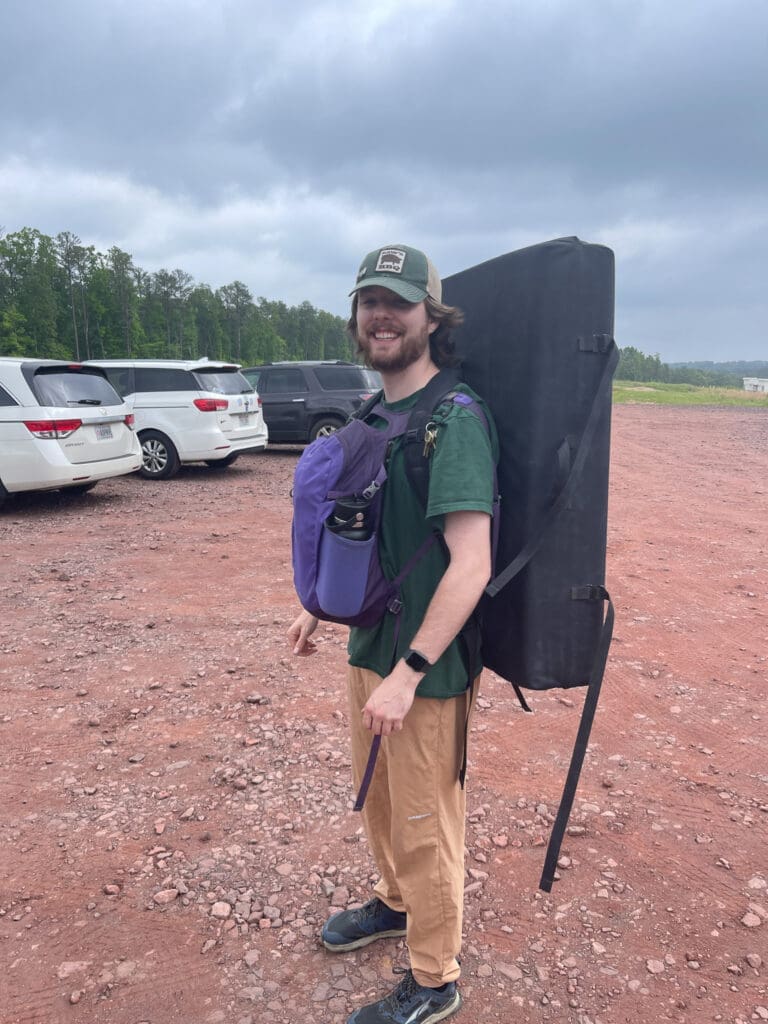
Before I keep going, I have to include a short pause. Climbing and the community around climbing has some funky terminology and systems. Before I talk about what we climbed, I’m going to go over some terms and the U.S. bouldering grading system.
There’s a lot of history and culture behind all of this, but that’s another tangent to go down, so I’ll be brief. Here are some need to know terms:
Crux: The crux of a climbing route is typically the hardest move or moves of the climb.
Send: Sending, which can be used as a verb or a noun, is interchangeably used for completing a route.
Slab: A type of boulder that has a slight incline or decline. Typically they boast tough crimps and minimal footholds requiring the climber to rely on their balance and finger strength.
Arete: An arete in climbing is the sharp corner or face of a boulder. Sometimes an arete can be pretty wide, sometimes it’s razor thin.
Top out: To top out means to finish the route and hoist yourself to the top of the boulder.
Downclimb: A downclimb is when you climb down the route. In bouldering, climbers often do a downclimb of the route to just get down, if they feel like they cannot top out or if they want another challenge.
Chalk: This is pretty self-explanatory, but the reason climbers use chalk on their hands is for a better grip on the rock. In outdoor bouldering, it can also be used to mark the holds you may use.
Crimp: A crimp is a small edge in the rock that’s barely large enough for the tips of your fingers.
Jug: A jug is another type of hold that resembles a jug handle. They’re comfortable, large holds.
Sloper: A sloper is a climbing hold that is essentially one large, curved edge. Imagine trying to grip the underside of a bowl if it had the texture of rock.
Smearing: Using your feet against the rock face to generate friction in place of an actual foot hold.
That’s pretty much all I may use, but if you want to learn more lingo, you can here.

Before I move on, though, I have to mention the grading system. There are several grading systems around the world to determine the difficulty level, in climbing. In the U.S. we predominantly use the Vermin Scale, or the V-scale for bouldering. It ranges from V0 to V17, but is always being pushed higher. V17 is currently the highest difficulty. Each rating can also have a plus or minus, which just means it may be slightly harder or easier than a whole rating.
We parked, grabbed our gear and headed out to the trail. Almost immediately after walking in, we spotted the first boulder we recognized. After walking around it and looking at the photos from our guidebook, we realized it was the Heart Boulder, aptly named for one of the holds looking like the shape of a heart.

Robbie and I wanted to climb straight away and tried finding a route named Bathroom Barbeque. It’s not in our guidebook, but is on Mountain Project – rated as a V1. Starting on the arete of the boulder on the left side near a tree with some poison ivy at the bottom, you climb and then traverse to your right to the top of the boulder. Robbie cleared it, but I didn’t go for it. Afterward, we shifted our pads to the right side of the boulder where I found the heart-shaped hold.
Looking around in our guidebook, we found two routes called the Heart and the Heart Drop. The Heart Drop is a V1 in our guidebook, and the Heart is a V3. The Heart Drop begins with a sit-start as you climb the steep 45 degree incline until you get to the sloped rock, where the incline becomes a normal vertical slab. The Heart is the same climb but just keeps going up the rest of the boulder face.

This route was brutal for me. While it had plenty of nice jugs, I ended up not finishing either route because it’s way out of my style of climbing. I’ve learned I tend to prefer slabs, or slightly inclined faces that require balancing with lots of crimps, and crack climbing, climbing up a crack in the rock.
Robbie, however, powered through the Heart Drop and decided to try for the Heart. As he kept climbing higher and higher, I started becoming increasingly concerned about him falling wrong or missing the pads if he fell. But, Robbie persevered and nailed the climb.

The main issue we kept running into at Moss Rock was that it’s April. It’s starting to get humid and hot, and the boulders have already been covered in moss and lichen. Some of the routes we wanted to do, including the Heart, were a little sketchy because we didn’t want to ruin the moss, and the moss makes it nearly impossible to see any holds.
We ended up taking a break for a minute and decided to head to a V2 overhang route we thought we could do, called Long Shot. You’re never more than four feet off the ground, and just climbing across an overhang. It sounds simple, but neither of us could get past the first three moves.

At this point we started getting humbled. In the gym, both of us can typically climb V4 routes after a few tries. Outside though, V1 and V2 routes were kicking our butts. So, we moved on. The next and last boulder of the day was in the Ozzy area.
Walking up to this boulder, the first one you see in the Ozzy area, you can tell it’s seen years of climbers. Leftover chalk and an old wooden perimeter on the ground where we could place our crash pads, the boulder seemed to shout at us to climb it. In this area specifically, we climbed three routes: the Ozzy Crack, graded at V0 with plenty of jugs and comfortable foot holds, an unnamed V0 to the left of the face with some decent crimps and a few jugs and then the Ozzy Slab in our guidebook, AKA General Lee on Mountain Project, graded at V2 to V3 which basically featured no footholds.
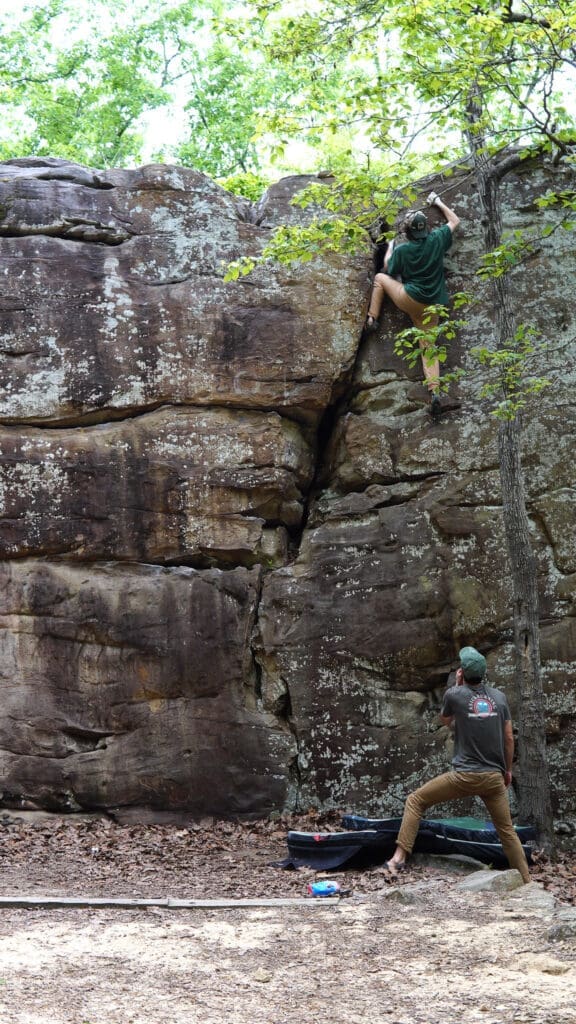
The Ozzy crack looked easy, and in hindsight, is easy. However, I’ve never topped out on a climb before. I’ve never had to mantle myself using sloped rock and what felt like untrustworthy rock over a boulder before. So, when I got to the top of the crack, I got in my head and instead of finishing it, downclimbed to try to re-chalk my hands and talk to Robbie about it.
He went up the crack, and brought some extra chalk to mark some holds he knew I could use. We’ve been climbing together for months now, and if anyone knows my limits in climbing, he does. I got back to the top, wedged my foot in the crack, smeared the wall with my other foot and hoisted myself over the wall using the holds Robbie marked with chalk. I told myself if I was going to fall, Robbie would make sure I was somewhat fine, and I’d just go again. So I shut out any doubts and sent it, making the Ozzy crack my first outdoor climb.
Even though it was just a V0, it felt like I just climbed for the first time. I’ve never felt so supported by a friend, and it felt like I truly conquered something. There is an astronomical difference between the feeling of your hands on actual rock, compared to plastic holds in a gym and a difference between completing a route that has been there for centuries, compared to something that gets reset every few weeks.
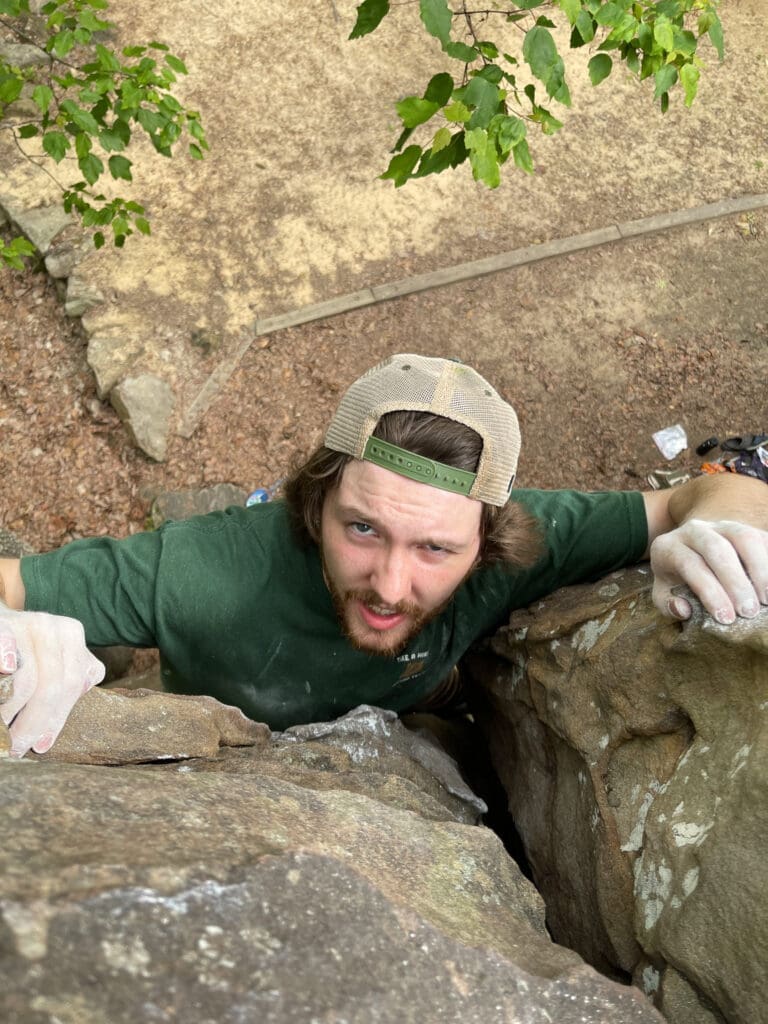
Afterwards, we tried the unnamed route. Robbie completed it and I got close but at that point I was pretty much spent. So it was then my turn to be the supportive roommate and climber. Robbie tried his hand at Ozzy Slab several times but couldn’t manage to break through the crux of the problem. We both called it quits, and had to head home.
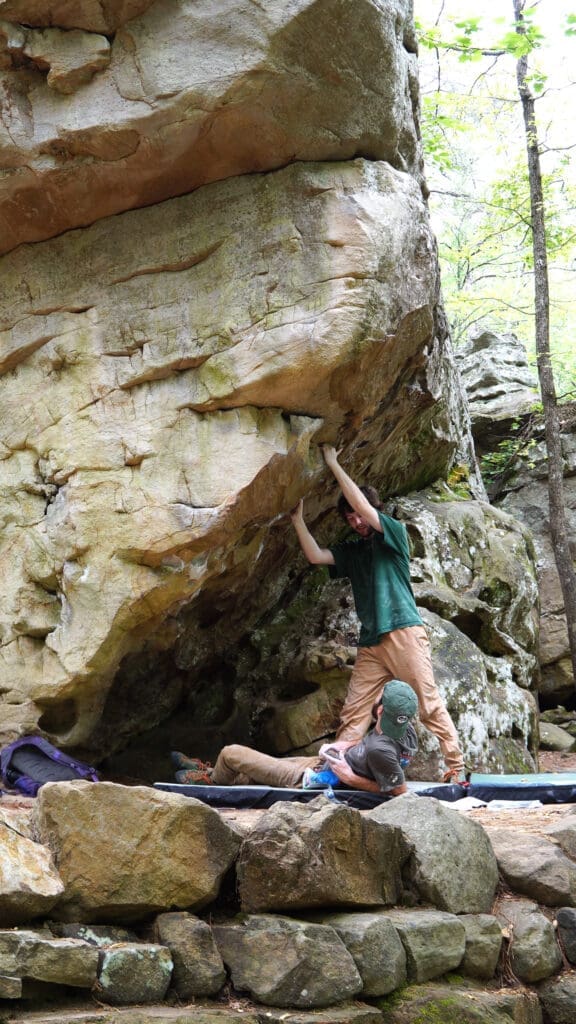
The experience I had at Moss Rock has me scouring Facebook marketplace for cheap crash pads. I’m entranced with the idea of climbing outdoors now. To put my hands on the same rock that someone like John Gill has makes me want to camp out at Moss Rock and climb day in and day out. Nearly every person that passed us on the trail cheered us on. They hung around with their dogs asking us questions as if we aren’t brand new to this, too. It felt great to be known as a climber.
Keep in mind though, Robbie and I are beginners. We both played sports growing up and were both fairly active before climbing, but we started climbing more consistently last fall. We still don’t really know what we’re doing, we just go up the wall.
I tell all my friends and anyone I know who likes being outdoors to try climbing. It has been an extremely welcoming community and if you have any interest, try it! A great organization that gave me an opportunity to climb my first sport route, which was the result of me just showing up to a cleanup day, is the Southeastern Climbing Coalition. They’re a non-profit dedicated to preserving climbing areas and ensuring equitable access to them. The SCC does a lot of great work in conservation, but also in getting new climbers more involved.

From the guy who, within a few minutes of conversation at High Point, gave us a guidebook, the people we met at an SCC volunteer cleanup who helped me try out my first outdoor sport route and told us to try Moss Rock, the worker at Birmingham Boulders who gave us a list of routes to seek out, to all of the people I’ve met climbing, they’ve all told me one thing: just send it.
The sheer support behind just sending a climb, even if you don’t fully finish it, is remarkable. If anyone asked me if they should try climbing, I would tell them yes for that reason alone.
Want to get early access to columns, unique newsletters and help keep The Sunrise News active? Then support us on Ko-Fi!
This article represents the opinions of its author. The views expressed here are not necessarily representative of The Sunrise News staff as a whole.


